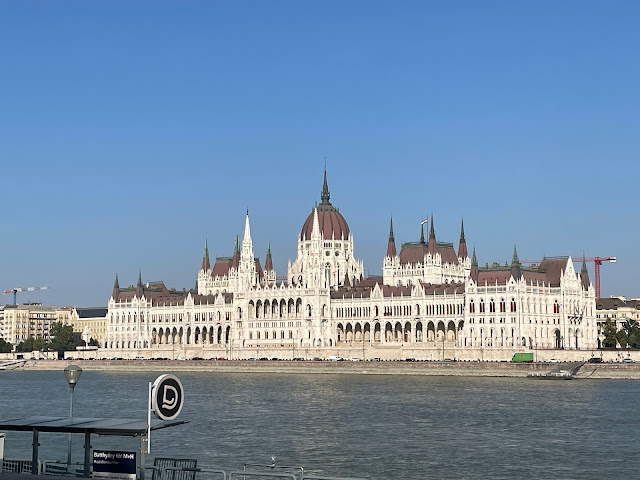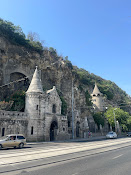From Buda to Pest and Then Some.
Our ninth month on the road finally found us in Europe. Hungary to be precise. Prior to Budapest, the longest we'd stayed in one spot was a week in Capetown, South Africa. Chaing Mai, Thailand was a close second for 6 days, and no more than 2 or 3 other five-day stops in the last 9 months. Most of our stays have been about 3 days on average. The pace sped up a lot when we were road-tripping in Africa, changing just about every night, so we were more than ready for an extended stay. Budapest wasn't somewhere necessarily on my radar, but Johnny found it when researching spots in Europe that wouldn't break the bank. With notable buildings and a lively nightlife, it seemed like a perfect first stop for the European leg of our trip and a good place to kick up our feet for the next 3 weeks.
.JPG) We stayed in District VII, also known as the Jewish Quarter. Once part of the Jewish ghetto, is now known for its ruin pubs and as a result, is now the "party district". I think directly out our window were no fewer than six different Gyro spots to serve the late-night revelers, which included ourselves more than a couple times. So. Much. Shawarma. (Without the pita for me, of course) Even with the regular 5 a.m. partiers hanging in the street below, it was a great spot to stay, giving us access to all the well-known tourist locations. In between relaxing at the apartment, watching some TV for the first time in months, and being able to cook every meal in a real kitchen, we did make sure to hit all the must-sees. From thermal baths to history museums, we took in the sites, but I must say, the thing that stood out to me the most was how charming the city was to just walk around in. It seemed that every street or alley you turned down offered some picturesque tidbit, like a colorful mural, a lively local watering hole, or a historic building of note. The city was clean, friendly, and unlike SE Asia, cars actually stopped for pedestrians!
We stayed in District VII, also known as the Jewish Quarter. Once part of the Jewish ghetto, is now known for its ruin pubs and as a result, is now the "party district". I think directly out our window were no fewer than six different Gyro spots to serve the late-night revelers, which included ourselves more than a couple times. So. Much. Shawarma. (Without the pita for me, of course) Even with the regular 5 a.m. partiers hanging in the street below, it was a great spot to stay, giving us access to all the well-known tourist locations. In between relaxing at the apartment, watching some TV for the first time in months, and being able to cook every meal in a real kitchen, we did make sure to hit all the must-sees. From thermal baths to history museums, we took in the sites, but I must say, the thing that stood out to me the most was how charming the city was to just walk around in. It seemed that every street or alley you turned down offered some picturesque tidbit, like a colorful mural, a lively local watering hole, or a historic building of note. The city was clean, friendly, and unlike SE Asia, cars actually stopped for pedestrians! 
Two museums visited that captured some of that history were the House of Terror and the Hospital in the Rocks. Both document parts of the Hungarian story from the 1930s onward. From the siege in 1944, to the revolution of 1956, what stood out to me is just how much rebuilding this city has had to do in recent decades. I learned that Hungary only gained its independence from the Soviets in 1989, as well as a long complicated story before that involves the Ottoman Empire (oh hey paprika in EVERYTHING), the Austrian-Hungarian Empire, and German alliances. (Also, please someone who knows this history better than me add any corrections in the comments for the 12 people who actually read this blog. I'm trying my best to summarize but I'm sure I made some mistakes in trying to generalize for brevity.)

The other places of note include the parliament building, a very impressive structure that houses the crown jewels. On the Buda side of the Danube River, we visited the Castle district with Fisherman's Bastion and the Citadella, beautiful and memorable in their old European feel (even if a lot of it is reconstructed). What I hadn't heard a lot about that is also worth mentioning is Margaret Island, a large park with various fountains, bars, and trails that was a really lovely green space right in the middle of the river.
And a final Budapest shoutout for their public transportation; one of the best I've seen in my travels. We mostly got around with the city bike system, which we were able to sign up for 1000 forint, less than US$3. For that amount, we could use the bikes as much as we wanted for a whole month and only had to pay if we kept them for over 30 minutes at a time. I used those bikes just about every day, most days multiple times. Best $2.79 I've spent. I also rode on the oldest metro in Europe, built in 1894, as well as some very cool trams that run right along the river. We could get anywhere for cheap, with each bus or tram ride only costing 450 forints ($1.26).
After almost 3 weeks in one spot, we were ready to hit the road again and took a rental car for a week to explore some of the Hungarian countryside. Substantially smaller than the Toyota Hilux Truck Johnny had in Namibia, his tiny Peugeot took some getting used to. The first stop was Esztergom, famous for its Basilica, and although the church was undergoing renovations, we were still able to walk around the dome at the top, giving quite the view of the Danube, as well as the Hungarian and Slovakian countryside. Esztergom is also situated right on the Slovakian border, and it was a quick walk between the two countries with just a line of paint on the bridge and a sign to let you know you crossed the border. I ultimately decided to not count Slovakia as country #15 since we just walked around a small border town for an evening, but it is still fun to say I have technically been to Slovakia.

Our last few stops would be centered around Lake Balaton. Although it was quiet in the off-season with many of the bars and restaurants closed for the year, we were still able to enjoy some days warm enough to dip in the lake. We stayed in Siófok on the South side of the Lake, and Hévíz on the North, tried some of the local Hungarian wines from the region, and used the few rainy days to relax and plan the next leg of our trip.












Orienteering for the win! Good job, Johnny! I never knew Budapest was two different parts of a city. So interesting! Count me in as one of the 12 (there’s definitely more!) who not only reads this blog but anxiously awaits the updates! Hope you’re taking care of yourself!! Cardozo misses you!!
ReplyDeleteI don’t read your blog consistently, but I go to it when I want to wind down. It’s fun to read where you have been, and your commentary. Thanks for taking the time to share your moments!
ReplyDelete